Rajasthan Board RBSE Class 12 Chemistry Chapter 15 Polymers
RBSE Class 12 Chemistry Chapter 15 Text Book Questions
RBSE Class 12 Chemistry Chapter 15 Multiple Choice Questions
Question 1.
Which of the following is not true about polymers?
(a) Polymers have low molecular weight.
(b) Polymers have no charge.
(c) Polymers have high viscosity.
(d) Polymers scatter light.
Question 2.
On the basis of the method of polymerisation, polymers are classified as:
(a) Only addition polymers
(b) Only condensation polymers
(c) Only addition and condensation polymers
(d) Copolymers
Question 3.
Teflon, styrene and neoprene are
(a) Copolymer
(b) Homopolymer
(c) Monomer
(d) Condensation polymer
Question 4.
Which of the following is condensation polymer?
(a) Dacron
(b) Teflon
(c) PVC
(d) Polythene
Question 5.
Which of the following is not a true polymer?
(a) Ethene
(b) Styrene
(c) Isoprene
(d) Butadiene
Question 6.
Which of the following has a ester bond?
(a) Nylon
(b) Bakelite
(c) Terylene
(d) Rubber
Question 7.
Terylene is a condensation polymer of ethylene glycol and:
(a) Terephthalic acid
(b) Phthalic acid
(c) Benzoic acid
(d) Acetic acid
Question 8.
The monomer of nylon – 6 is
(a) Adipic acid
(b) Caprolactum
(c) 1, 3 butadiene
(d) Chloroprene
Question 9.
Teflon is a polymer of:
(a) Tetrafluoroethylene
(b) Tetraiodoethylene
(c) Tetrachloroethylene
(d) Tetrabromoethylene
Question 10.
Which of the following is a bio-degradable polymer?
(a) PVC
(b) Cellulose
(c) Polythene
(d) Nylon – 6
Answers:
1. (a)
2. (c)
3. (b)
4. (a)
5. (c)
6. (c)
7. (a)
8. (b)
9. (a)
10. (b)
RBSE Class 12 Chemistry Chapter 15 Very Short Answer Type Questions
Question 1.
Define polymers?
Answer:
Polymers are high molecular mass (103 – 107u) substances consisting of a very large number of simple repeating structural units
joined together through covalent bonds in a linear fashion.
Example: Polythene, Nylon – 6,6, Bakelite etc.
Question 2.
Give an example of natural and synthetic polymers.
Answer:
Natural polymers – Natural rubber

Synthetic polymer – Nylon 6, 6

Question 3.
Give one difference between homopolymer and copolymer.
Answer:
Homopolymer:
A polymer formed from only one kind of repeating units or monomer is called homopolymer.
Example: PVC is a homopolymer.
Copolymer:
A polymer formed from more than one kind of monomer units is called copolymer or mixed polymer.
Example: – 1, 3 – butadiene and styrene are examples of the mixed polymer.
Question 4.
How many methods of chain termination are there in the free radical mechanism?
Answer:
There are three methods of chain termination in the free radical mechanism.
- Chain initiating.
- Chain propagation.
- Chain termination.
Question 5.
Which monomers are polymerised by cationic polymerisation?
Answer:
A vinyl derivative is monomers polymerised by cationic polymerisation.
Question 6.
Write a formula for number average molecular mass.
Answer:
![]()
Question 7.
Give the name of substances used in the vulcanisation of rubber.
Answer:
S (Sulphur).
Question 8.
Write the name of the monomer of neoprene.
Answer:
2 – Chlorobuta – 1, 3 diene is the monomer of neoprene.

Question 9.
Write the chemical formula of Nylon – 6, 6.
Answer:

Question 10.
Give two examples of synthetic biopolymers.
Answer:
- PHBV (Poly β – hydroxybutyrate – co – β hydroxy valerate)
- Nylon – 2, 6
RBSE Class 12 Chemistry Chapter 15 Short Answer Type Questions
Question 1.
On the basis of the source of how polymers are classified? Give one example of each?
Answer:
On the basis of source polymers are classified as:
- Natural polymers (Example: Starch, Cellulose, Portions etc.)
- Synthetic polymers (Example: PVC, -Nylon Teflon etc.)
- Semi-synthetic polymers (Example.- Rayon, Cellulose nitrate)
Question 2.
Write differences between thermosetting and thermoplastic polymers.
Answer:
Thermoplastic polymers:
These are linear or slightly branched long chain molecules capable of repeatedly softening on heating and hardening on cooling. These polymers possess intermolecular forces of attraction intermediate between those in elastomers and fibres. Polythene and polystyrene are examples of thermoplastic polymers.
Thermosetting polymers:
These polymers are cross-linked or heavily branched molecules which on heating undergo extensive cross-linking in moulds and become infusible. These cannot be reused. Bakelite, urea formaldehyde, resins are examples of thermosetting polymers.
Question 3.
In free radical polymerisation, where do we use hydroquinone? Explain.
Answer:
Benzoquinone combines with free radical intermediate to form of non-reactive radical, which is highly stabilized by resonance.
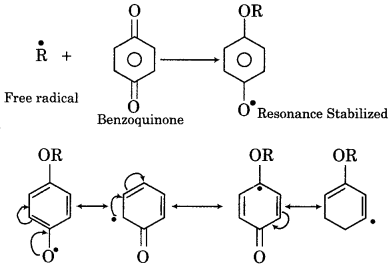
Question 4.
Give the monomer of dacron and process of polymerisation of dacron.
Answer:
The monomer of dacron is:

It is also known as terylene and is the condensation product of ethylene glycol and terephthalic acid polymerisation is carried out at 420 to 460 K in the presence of zinc acetate and antimony trioxide.
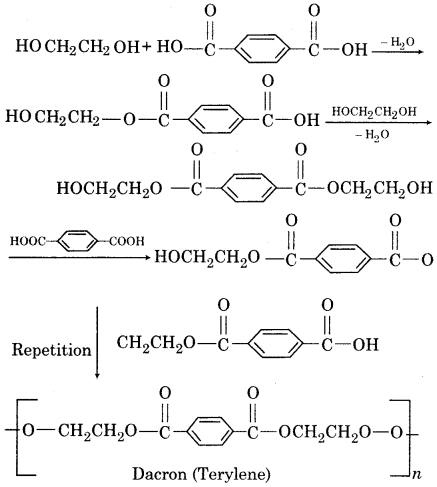
Question 5.
What is the polydispersity index? Explain.
Answer:
Polydispersity Index:
In order to have an idea about the homogeneity of a polymer, we define the term polydispersity index. It is the ratio of mass average molecular mass to the number average molecular mass.

- For natural polymers, PDI is usually equal to one which means that they are monodisperse. Such polymers are more homogeneous.
- Synthetic polymers on the contrary generally have PDI > 1 which means that they were less homogeneous.
Question 6.
Why rubber is vulcanised? Explain.
Answer:
Natural rubber is soft and sticky at high temperatures and brittle at low temperatures. Therefore rubber is generally used in the narrow
temperature range (283 – 335 K) where its elasticity maintained. So to improve the property of natural rubber, it is vulcanised by heating it with about 5% sulphur at 373 K – 415 K.
Question 7.
What do LDPE and HOPE indicate? How are they formed?
Answer:
Low-Density polyethene (LDPE):
It is obtained by heating very pure ethylene at 350 K – 570 K under a pressure of about 1500 atm in the presence of traces of oxygen. It is a highly branched polymer. It is chemically inert, tough but flexible. It is used for packing, cable insulation and in the manufacture of pipes, toys etc.
High-Density polyethene (HDPE):
It is obtained by polymerisation of ethylene at about 333 – 343 K under 6 to 7 atmospheric pressure in the pressure of catalysts such as triethyl aluminium and titanium tetrachloride. It is chemically inert having greater toughness and hardness.
Question 8.
Write the names of monomers and structures of the following polymers:
- Teflon
- Terylene
- Nylon – 6, 6
- Bakelite
Answer:
1. Teflon – Monomer – CF2 = CF2 (Tetrafluoroethylene)

2. Terylene – Monomers
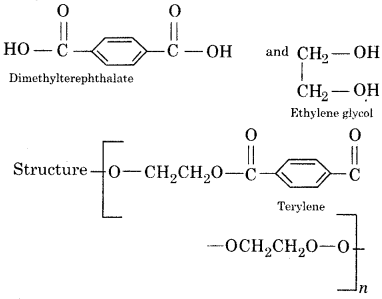
3. Nylon – 6, 6
Monomers – HOOC – (CH2)4 – COOH (Adipic acid) and H2N – (CH2)6 – NH9 (Hexamethylene diamine)

4. Bakelite
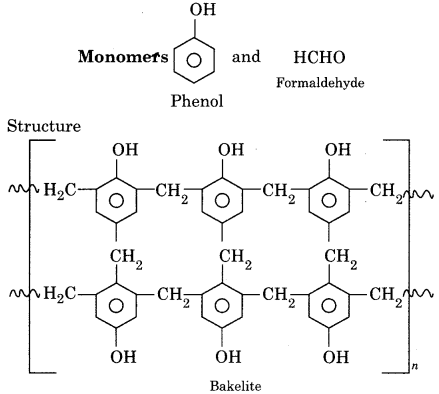
Question 9.
What is PHBV?
Answer:
Polyhydroxybutyrate – Co – β – hydroxy valerate PHBV is used in especially packing. Orthopaedic devices and in controlled release of drugs. PHBV undergoes bacterial degradation in the environment.
Question 10.
Why the PDI of proteins is equal to one?
Answer:
For a protein, the weight average molecular weight is equal to the number average molecular mass. Therefore the value of PDI for a protein is equal to one.
RBSE Class 12 Chemistry Chapter 15 Long Answer Type Questions
Question 1.
Classify polymers on the following basis:
(i) On the basis of monomer units.
(ii) Type of polymerisation.
(iii) Molecular forces.
Answer:
(i) On the basis of monomer units:
Polymers can be classified into two types:
1. Homopolymers:
A polymer formed from only one kind of repeating units or monomers is called homopolymer.
Example: Polythene and PVC.
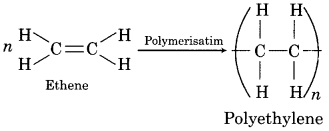
2. Copolymers:
A polymer formed from more than one kind of monomer units is called copolymer or mixed polymer. For example, Buna – S rubber which formed from 1, 3 – butadiene and styrene are examples of the copolymer.
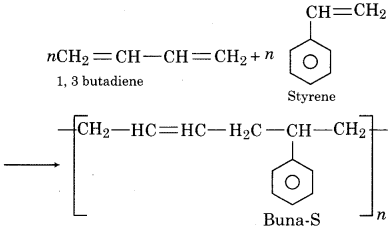
(ii) Type of polymers:
Carothers in 1928 classified polymers on the basis of polymerisation process into two groups:
1. Addition polymers
2. Condensation polymers.
1. Addition polymers:
A polymer formed by direct addition of repeated monomer molecules possessing double or triple bond, without the elimination of any small molecule is called addition polymer.
Example: PVC, Teflon, Neoprene etc.
2. Condensation polymers:
These polymers are formed through a series of independent reactions. These reactions involve the bond formation condensation between two difunctional monomer molecules to form dimers, which in turn, produce tetramers and so on (with the loss of simple molecules like NH3, H2O etc.).
Example: Bakelite, Nylon – 6, 6 etc.
(iii) Type of polymers on the basis of molecular forces operating between different polymer chains, the polymers are of the
following types:
- Elastomers: (Example: vulcanised rubber, natural rubber etc)
- Fibres: (Example: nylon, Orlon, polyesters)
- Thermoplastics Polymers: (Example: polypropylene, polythene etc)
- Thermosetting polymers: (e.g. Bakelite, phenol-formaldehyde resin etc)
Question 2.
What is an addition polymerisation? Explain free radical addition polymerisation mechanism by taking an example.
Answer:
Addition polymerization:
A polymer formed by direct addition of repeated monomer molecules possessing double or triple bond, without the elimination of any small molecule is called addition polymerisation.
Example: polythene, PVC etc.
Mechanism of free radical addition is completed in three parts:
1. Chain initiating step:
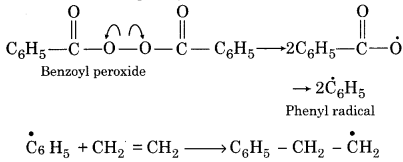
2. Chain propagating step:
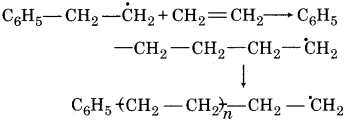
3. Chain terminating step:
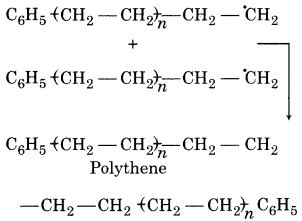
Question 3.
How natural rubber is obtained? Write its composition and structure.
Answer:
To obtain natural rubber first of all latex of rubber plant is obtained. The latex contains, about 25 – 40% of rubber hydrocarbons dispersed in water along with stabilizer proteins and some fatty acids are mixed due to which rubber coagulates and precipitated out. It is separated by filtration. This rubber is known as crepe rubber.
Structure and composition:
Natural rubber may be considered as a linear polymer of isoprene (2 – methyl – 1, 3 butadiene) and also called as cis – 1,4 polyisoprene.
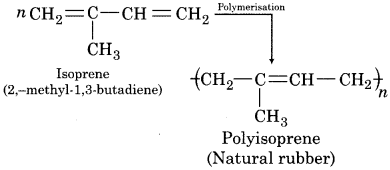
Question 4.
Why the molecular mass of polymers is taken as average molecular mass? Explain how many types of average molecular mass can be represented? Explain each type.
Answer:
A polymer sample contains chains of varying lengths and therefore its molecular mass. is always expressed as an average. On the other hand, natural polymers such as proteins contain chains of identical length and therefore they have definite molecular mass. The molecular mass of polymers can be expressed in two ways:
(i) Number average molecular mass (Mn):
If N1, N2, N3 … are the number of molecules with molecular masses M1, M2, M3 …. respectively then the number average molecular mass is

This may be expressed as
![]()
where Ni is the number of molecules with molecular mass Mi.
(ii) Weight average molecular mass (Mw):
If m1, m2, m3…are the masses of species with molecular masses M1, M2, M3… respectively, then the weight average molecular mass is:
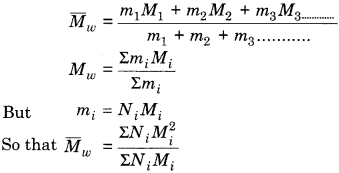
where Ni is the number of molecules of mass Mi.
Question 5.
Write a short note on biopolymers and biodegradable polymers.
Answer:
1. Biopolymers:
Many polymers which are present in plants and animals such as polysaccharides (starch, cellulose), proteins and nucleic acid etc. which control various life processes in plants and animals are called biopolymers.
Examples: Protein, Carbohydrates, Nucleic acid, Lipids etc.
2. Biodegradable:
The polymers which are degraded by microorganisms within a suitable time period so that the polymers and their degraded products do not cause any serious effects on the environment are called biodegradable polymers.
Example: polylactic acid (PLA), Polyglycolic acid (PGA) and PHB etc.
Question 6.
Write method of polymerisations and uses of the following polymers:
- Bakelite
- PVC
- Polyester
- Nylon – 66
Answer:
1. Bakelite:
It is condensation polymer and is obtained from phenol and formaldehyde in the presence of either an acid or a base catalyst.
Uses:
Soft Bakelite with low degree polymerisation is used for making glue for binding laminated wooden planks and varnishes, High degree polymerisation gives hard bakelite which is making combs, fountain pens, barrels, electrical switches etc.
2. PVC:
It is an addition polymer. A polymer formed by direct addition of repeated monomers without the elimination of byproduct molecules is called addition polymer.
Uses:
PVC plastic is used to manufacture bottles that have application in a wide range of industries.
3. Polyesters:
Polyesters are condensation polymers.
Uses:
It is used
- In blending with cotton or wool fibres because it increases resistant.
- As glass reinforcing material in safety helmets.
4. Nylon – 66:
Nylon 66 is a condensation polymer.
It is used:
- In making bristles for brushes.
- In the manufacture of cords and climbing ropes.